-
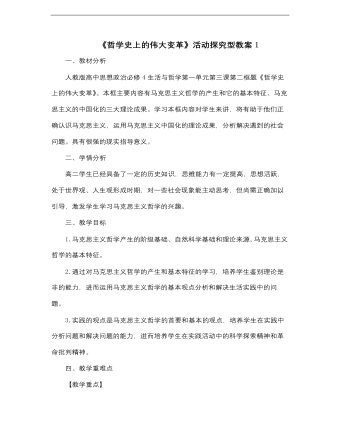
高中思想政治人教版必修四《哲学史上的伟大变革活动探究型》教案
一、教材分析人教版高中思想政治必修4生活与哲学第一单元第三课第二框题《哲学史上的伟大变革》。本框主要内容有马克思主义哲学的产生和它的基本特征、马克思主义的中国化的三大理论成果。学习本框内容对学生来讲,将有助于他们正确认识马克思主义,运用马克思主义中国化的理论成果,分析解决遇到的社会问题。具有很强的现实指导意义。二、学情分析高二学生已经具备了一定的历史知识,思维能力有一定提高,思想活跃,处于世界观、人生观形成时期,对一些社会现象能主动思考,但尚需正确加以引导,激发学生学习马克思主义哲学的兴趣。三、教学目标1.马克思主义哲学产生的阶级基础、自然科学基础和理论来源,马克思主义哲学的基本特征。2.通过对马克思主义哲学的产生和基本特征的学习,培养学生鉴别理论是非的能力,进而运用马克思主义哲学的基本观点分析和解决生活实践中的问题。3.实践的观点是马克思主义哲学的首要和基本的观点,培养学生在实践中分析问题和解决问题的能力,进而培养学生在实践活动中的科学探索精神和革命批判精神。
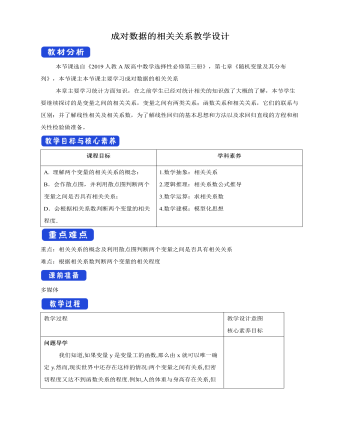
人教版高中数学选修3成对数据的相关关系教学设计
由样本相关系数??≈0.97,可以推断脂肪含量和年龄这两个变量正线性相关,且相关程度很强。脂肪含量与年龄变化趋势相同.归纳总结1.线性相关系数是从数值上来判断变量间的线性相关程度,是定量的方法.与散点图相比较,线性相关系数要精细得多,需要注意的是线性相关系数r的绝对值小,只是说明线性相关程度低,但不一定不相关,可能是非线性相关.2.利用相关系数r来检验线性相关显著性水平时,通常与0.75作比较,若|r|>0.75,则线性相关较为显著,否则不显著.例2. 有人收集了某城市居民年收入(所有居民在一年内收入的总和)与A商品销售额的10年数据,如表所示.画出散点图,判断成对样本数据是否线性相关,并通过样本相关系数推断居民年收入与A商品销售额的相关程度和变化趋势的异同.
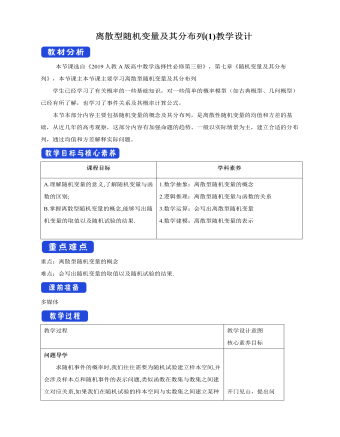
人教版高中数学选修3离散型随机变量及其分布列(1)教学设计
4.写出下列随机变量可能取的值,并说明随机变量所取的值表示的随机试验的结果.(1)一个袋中装有8个红球,3个白球,从中任取5个球,其中所含白球的个数为X.(2)一个袋中有5个同样大小的黑球,编号为1,2,3,4,5,从中任取3个球,取出的球的最大号码记为X.(3). 在本例(1)条件下,规定取出一个红球赢2元,而每取出一个白球输1元,以ξ表示赢得的钱数,结果如何?[解] (1)X可取0,1,2,3.X=0表示取5个球全是红球;X=1表示取1个白球,4个红球;X=2表示取2个白球,3个红球;X=3表示取3个白球,2个红球.(2)X可取3,4,5.X=3表示取出的球编号为1,2,3;X=4表示取出的球编号为1,2,4;1,3,4或2,3,4.X=5表示取出的球编号为1,2,5;1,3,5;1,4,5;2,3,5;2,4,5或3,4,5.(3) ξ=10表示取5个球全是红球;ξ=7表示取1个白球,4个红球;ξ=4表示取2个白球,3个红球;ξ=1表示取3个白球,2个红球.
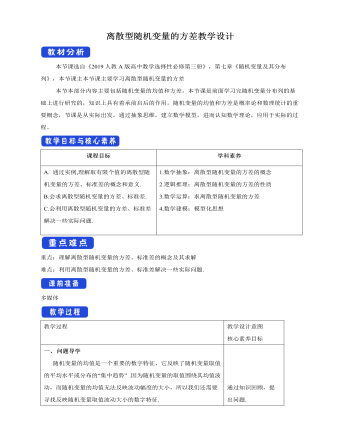
人教版高中数学选修3离散型随机变量的方差教学设计
3.下结论.依据均值和方差做出结论.跟踪训练2. A、B两个投资项目的利润率分别为随机变量X1和X2,根据市场分析, X1和X2的分布列分别为X1 2% 8% 12% X2 5% 10%P 0.2 0.5 0.3 P 0.8 0.2求:(1)在A、B两个项目上各投资100万元, Y1和Y2分别表示投资项目A和B所获得的利润,求方差D(Y1)和D(Y2);(2)根据得到的结论,对于投资者有什么建议? 解:(1)题目可知,投资项目A和B所获得的利润Y1和Y2的分布列为:Y1 2 8 12 Y2 5 10P 0.2 0.5 0.3 P 0.8 0.2所以 ;; 解:(2) 由(1)可知 ,说明投资A项目比投资B项目期望收益要高;同时 ,说明投资A项目比投资B项目的实际收益相对于期望收益的平均波动要更大.因此,对于追求稳定的投资者,投资B项目更合适;而对于更看重利润并且愿意为了高利润承担风险的投资者,投资A项目更合适.
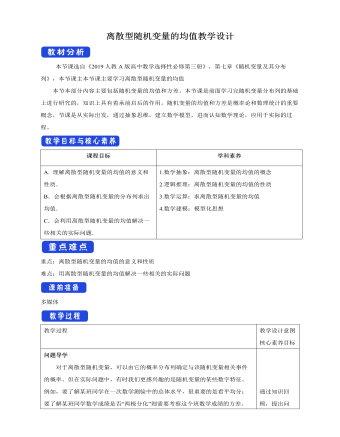
人教版高中数学选修3离散型随机变量的均值教学设计
对于离散型随机变量,可以由它的概率分布列确定与该随机变量相关事件的概率。但在实际问题中,有时我们更感兴趣的是随机变量的某些数字特征。例如,要了解某班同学在一次数学测验中的总体水平,很重要的是看平均分;要了解某班同学数学成绩是否“两极分化”则需要考察这个班数学成绩的方差。我们还常常希望直接通过数字来反映随机变量的某个方面的特征,最常用的有期望与方差.二、 探究新知探究1.甲乙两名射箭运动员射中目标靶的环数的分布列如下表所示:如何比较他们射箭水平的高低呢?环数X 7 8 9 10甲射中的概率 0.1 0.2 0.3 0.4乙射中的概率 0.15 0.25 0.4 0.2类似两组数据的比较,首先比较击中的平均环数,如果平均环数相等,再看稳定性.假设甲射箭n次,射中7环、8环、9环和10环的频率分别为:甲n次射箭射中的平均环数当n足够大时,频率稳定于概率,所以x稳定于7×0.1+8×0.2+9×0.3+10×0.4=9.即甲射中平均环数的稳定值(理论平均值)为9,这个平均值的大小可以反映甲运动员的射箭水平.同理,乙射中环数的平均值为7×0.15+8×0.25+9×0.4+10×0.2=8.65.
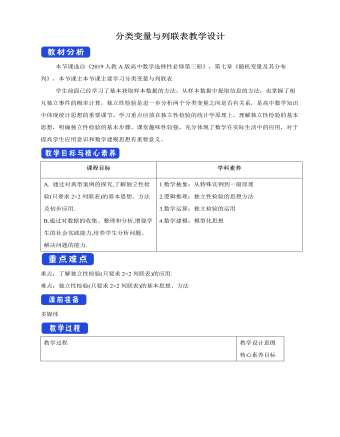
人教版高中数学选修3分类变量与列联表教学设计
一、 问题导学前面两节所讨论的变量,如人的身高、树的胸径、树的高度、短跑100m世界纪录和创纪录的时间等,都是数值变量,数值变量的取值为实数.其大小和运算都有实际含义.在现实生活中,人们经常需要回答一定范围内的两种现象或性质之间是否存在关联性或相互影响的问题.例如,就读不同学校是否对学生的成绩有影响,不同班级学生用于体育锻炼的时间是否有差别,吸烟是否会增加患肺癌的风险,等等,本节将要学习的独立性检验方法为我们提供了解决这类问题的方案。在讨论上述问题时,为了表述方便,我们经常会使用一种特殊的随机变量,以区别不同的现象或性质,这类随机变量称为分类变量.分类变量的取值可以用实数表示,例如,学生所在的班级可以用1,2,3等表示,男性、女性可以用1,0表示,等等.在很多时候,这些数值只作为编号使用,并没有通常的大小和运算意义,本节我们主要讨论取值于{0,1}的分类变量的关联性问题.
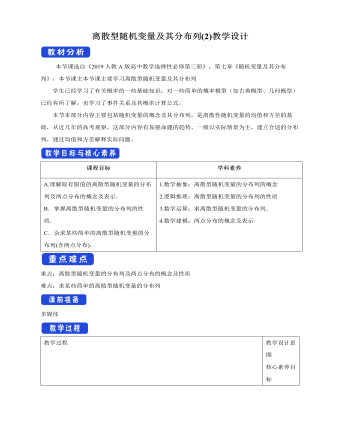
人教版高中数学选修3离散型随机变量及其分布列(2)教学设计
温故知新 1.离散型随机变量的定义可能取值为有限个或可以一一列举的随机变量,我们称为离散型随机变量.通常用大写英文字母表示随机变量,例如X,Y,Z;用小写英文字母表示随机变量的取值,例如x,y,z.随机变量的特点: 试验之前可以判断其可能出现的所有值,在试验之前不可能确定取何值;可以用数字表示2、随机变量的分类①离散型随机变量:X的取值可一、一列出;②连续型随机变量:X可以取某个区间内的一切值随机变量将随机事件的结果数量化.3、古典概型:①试验中所有可能出现的基本事件只有有限个;②每个基本事件出现的可能性相等。二、探究新知探究1.抛掷一枚骰子,所得的点数X有哪些值?取每个值的概率是多少? 因为X取值范围是{1,2,3,4,5,6}而且"P(X=m)"=1/6,m=1,2,3,4,5,6.因此X分布列如下表所示
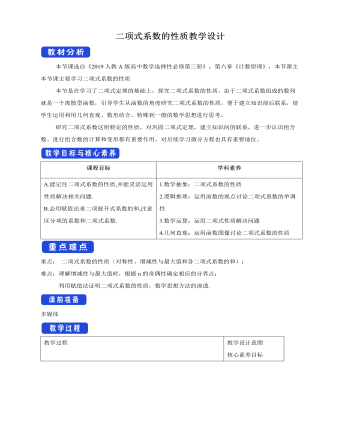
人教版高中数学选修3二项式系数的性质教学设计
1.对称性与首末两端“等距离”的两个二项式系数相等,即C_n^m=C_n^(n"-" m).2.增减性与最大值 当k(n+1)/2时,C_n^k随k的增加而减小.当n是偶数时,中间的一项C_n^(n/2)取得最大值;当n是奇数时,中间的两项C_n^((n"-" 1)/2) 与C_n^((n+1)/2)相等,且同时取得最大值.探究2.已知(1+x)^n =C_n^0+C_n^1 x+...〖+C〗_n^k x^k+...+C_n^n x^n 3.各二项式系数的和C_n^0+C_n^1+C_n^2+…+C_n^n=2n.令x=1 得(1+1)^n=C_n^0+C_n^1 +...+C_n^n=2^n所以,(a+b)^n 的展开式的各二项式系数之和为2^n1. 在(a+b)8的展开式中,二项式系数最大的项为 ,在(a+b)9的展开式中,二项式系数最大的项为 . 解析:因为(a+b)8的展开式中有9项,所以中间一项的二项式系数最大,该项为C_8^4a4b4=70a4b4.因为(a+b)9的展开式中有10项,所以中间两项的二项式系数最大,这两项分别为C_9^4a5b4=126a5b4,C_9^5a4b5=126a4b5.答案:1.70a4b4 126a5b4与126a4b5 2. A=C_n^0+C_n^2+C_n^4+…与B=C_n^1+C_n^3+C_n^5+…的大小关系是( )A.A>B B.A=B C.A<B D.不确定 解析:∵(1+1)n=C_n^0+C_n^1+C_n^2+…+C_n^n=2n,(1-1)n=C_n^0-C_n^1+C_n^2-…+(-1)nC_n^n=0,∴C_n^0+C_n^2+C_n^4+…=C_n^1+C_n^3+C_n^5+…=2n-1,即A=B.答案:B
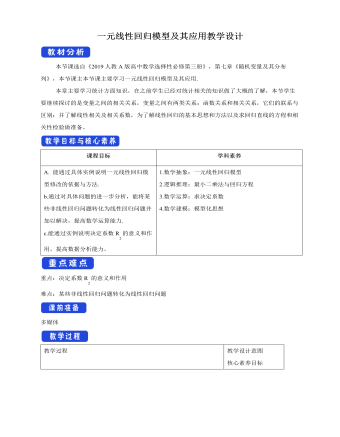
人教版高中数学选修3一元线性回归模型及其应用教学设计
1.确定研究对象,明确哪个是解释变量,哪个是响应变量;2.由经验确定非线性经验回归方程的模型;3.通过变换,将非线性经验回归模型转化为线性经验回归模型;4.按照公式计算经验回归方程中的参数,得到经验回归方程;5.消去新元,得到非线性经验回归方程;6.得出结果后分析残差图是否有异常 .跟踪训练1.一只药用昆虫的产卵数y与一定范围内的温度x有关,现收集了6组观测数据列于表中: 经计算得: 线性回归残差的平方和: ∑_(i=1)^6?〖(y_i-(y_i ) ?)〗^2=236,64,e^8.0605≈3167.其中 分别为观测数据中的温度和产卵数,i=1,2,3,4,5,6.(1)若用线性回归模型拟合,求y关于x的回归方程 (精确到0.1);(2)若用非线性回归模型拟合,求得y关于x回归方程为 且相关指数R2=0.9522. ①试与(1)中的线性回归模型相比较,用R2说明哪种模型的拟合效果更好 ?②用拟合效果好的模型预测温度为35℃时该种药用昆虫的产卵数.(结果取整数).
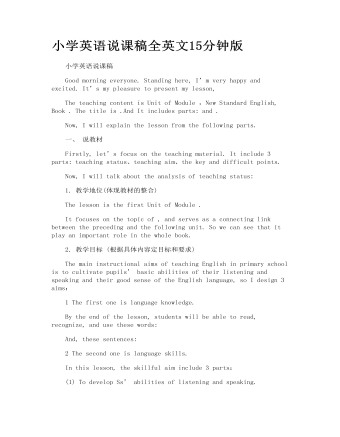
小学英语说课稿全英文15分钟版
一、 说教材 Firstly, let’s focus on theteaching material. It include 3 parts: teaching status、teachingaim、the key and difficult points. Now, I will talk about the analysis of teaching status: 1. 教学地位(体现教材的整合) The lesson is the first Unit of Module . It focuses on the topic of , and serves as a connectinglink between the preceding and the following unit. So we can see that it playan important role in the whole book. 2. 教学目标 (根据具体内容定目标和要求) The main instructional aims of teaching English inprimary school is to cultivate pupils’ basic abilitiesof their listening and speaking and their good sense of the English language,so I design 3 aims:

蓝黄色英语教师英文简历
Major in:Chinese, mathematics,foreign languages, history, ideology and politics, geography, chemistry,physics, biologyEnglishmajor, undergraduate, majoring in: English intensive reading, English extensivereading, English listening, English grammar, oral English, English writingEducationmajor, graduate student, major in: introduction to education, generalpsychology, developmental psychology, educational psychology
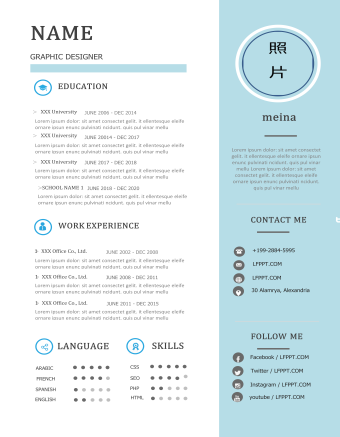
清新英文简历模板
Lorem ipsum dolor: sit ametconsectet gelit. it ellentesque eleife ornare ipsun enunc pulvinati ncidunt.quis pul vinar mellu Lorem ipsum dolor: sit amet consectet gelit. itellentesque eleife ornare ipsun enunc pulvinati ncidunt. quis pul vinar mellu。Loremipsum dolor: sit amet consectet gelit. it ellentesque eleife ornare ipsun enuncpulvinati ncidunt. quis pul vinar mellu.
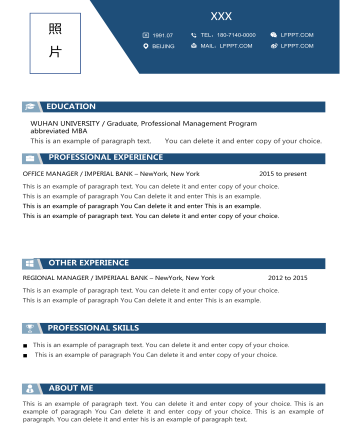
个人求职英文简历模板
OFFICE MANAGER / IMPERIAL BANK – NewYork, NewYork 2015 to presentThis is an example of paragraph text. You can delete it and enter copyof your choice. This is an example of paragraph You Can delete it and enter This is anexample. This is anexample of paragraph You Can delete it and enter This is an example. This is anexample of paragraph text. You can delete it and enter copy of your choice.
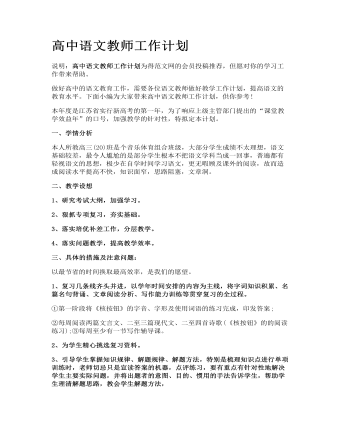
高中语文教师工作计划
二、教学设想1、研究考试大纲,加强学习。2、狠抓专项复习,夯实基础。3、落实培优补差工作,分层教学。4、落实问题教学,提高教学效率。
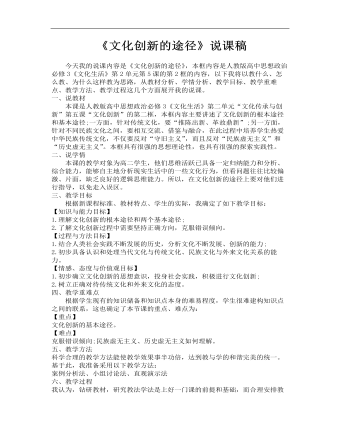
高中思想政治人教版必修三《文化创新的途径》说课稿
二、说学情本课的教学对象为高二学生,他们思维活跃已具备一定归纳能力和分析、综合能力,能够自主地分析现实生活中的一些文化行为,但看问题往往比较偏激、片面,缺乏良好的逻辑思维能力。所以,在文化创新的途径上要对他们进行指导,以免走入误区。三、教学目标根据新课程标准、教材特点、学生的实际,我确定了如下教学目标:【知识与能力目标】1.理解文化创新的根本途径和两个基本途径;2.了解文化创新过程中需要坚持正确方向,克服错误倾向。
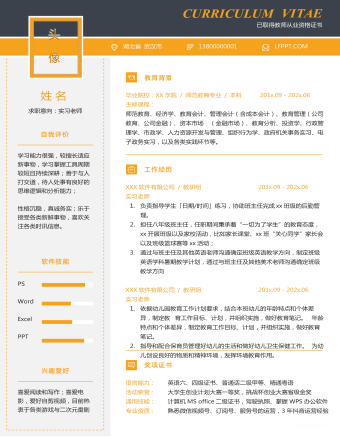
师范英语教师简历
XXX软件有限公司 / 教研组 201x.09 - 202x.06实习老师1. 负责指导学生「日期/时间」练习,协助班主任完成xx班级的后勤管理。2. 担任八年级班主任,任职期间秉承着“一切为了学生”的教育态度,xx开展班级以及家校活动,比如家长课堂、xx班“关心同学”家长会以及班级篮球赛等xx活动;通过与班主任及其他英语老师沟通确定班级英语教学方向,制定班级英语学科暑期教学计划,通过与班主任及其他美术老师沟通确定班级教学方向
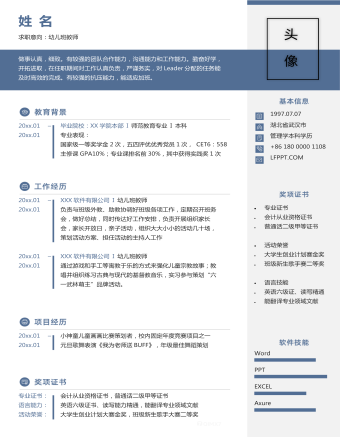
简历英语幼教模板
XXX软件有限公司 I 幼儿班教师负责与班级外教、助教协调好班级各项工作,定期召开班务会,做好总结,同时传达好工作安排,负责开展组织家长会,家长开放日,亲子活动,组织大大小小的活动几十场,策划活动方案、担任活动的主持人工作XXX软件有限公司 I 幼儿班教师通过游戏和手工等寓教于乐的方式来强化儿童宗教故事;教唱并组织练习古典与现代的基督教音乐,实习参与策划“六一武林萌主”品牌活动。
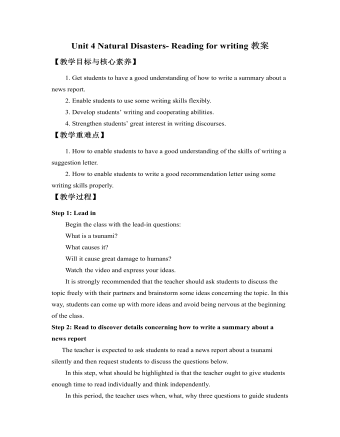
新人教版高中英语必修1Unit 4 Natural Disasters- Reading for writing教案
①标题——标题应当简洁明了。②导语——导语是消息开头的第一段或第一句话,简明扼要地揭示出消息的核心内容。③主体——主体是消息的主要部分,要用充足的事实表现主题,对导语的内容作进一步的展开和阐述。④结束语——通常是对全文内容进行概括性的总结。3. 新闻报道增分句子(1)陈述事实常用的句型:①A terrible storm hit/struck ... , killing ..②It was a cool autumn night when the earthquake happened. A large number of buildings fell down and roads were destroyed, leaving a great many people homeless.地震发生在一个凉爽的秋夜。大量的建筑物倒塌,道路被毁,许多人无家可归。③With the help of the rescue team, people who were the trapped in the flood were saved.在救援队的帮助下,困在洪水中的人们得救了。(2)陈述观点常用的句型:①Clearly/Obviously/In my opinion/It seemed that people were shocked.显然/在我看来/似乎人们震惊了。②The whole city was in ruins after the earthquake.地震后整个城市成了一片废墟。(3)揭示原因常用的句型:Because of/As a result of/Thanks to the help of the army, people who got injured were sent to the hospital immediately.
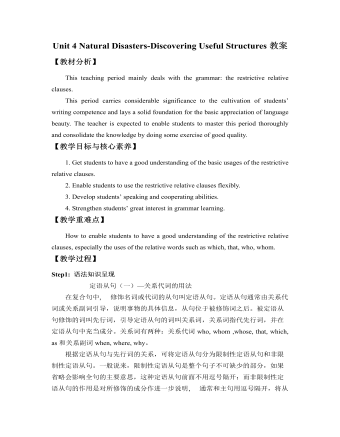
新人教版高中英语必修1Unit 4 Natural Disasters-Discovering Useful Structures教案
【教材分析】This teaching period mainly deals with the grammar: the restrictive relative clauses.This period carries considerable significance to the cultivation of students’ writing competence and lays a solid foundation for the basic appreciation of language beauty. The teacher is expected to enable students to master this period thoroughly and consolidate the knowledge by doing some exercise of good quality.【教学目标与核心素养】1. Get students to have a good understanding of the basic usages of the restrictive relative clauses.2. Enable students to use the restrictive relative clauses flexibly.3. Develop students’ speaking and cooperating abilities.4. Strengthen students’ great interest in grammar learning.【教学重难点】How to enable students to have a good understanding of the restrictive relative clauses, especially the uses of the relative words such as which, that, who, whom.【教学过程】Step1: 语法知识呈现定语从句(一)—关系代词的用法在复合句中, 修饰名词或代词的从句叫定语从句。定语从句通常由关系代词或关系副词引导,说明事物的具体信息,从句位于被修饰词之后。被定语从句修饰的词叫先行词,引导定语从句的词叫关系词,关系词指代先行词,并在定语从句中充当成分。关系词有两种:关系代词who, whom ,whose, that, which, as和关系副词when, where, why。
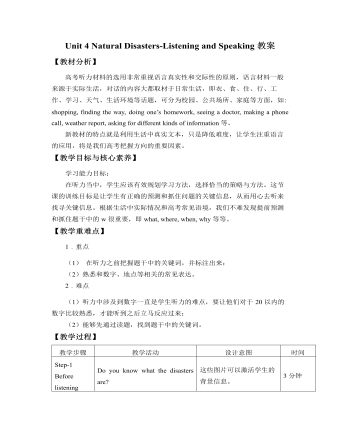
新人教版高中英语必修1Unit 4 Natural Disasters-Listening and Speaking教案
【教材分析】高考听力材料的选用非常重视语言真实性和交际性的原则,语言材料一般来源于实际生活,对话的内容大都取材于日常生活,即衣、食、住、行、工作、学习、天气、生活环境等话题,可分为校园、公共场所、家庭等方面,如: shopping, finding the way, doing one’s homework, seeing a doctor, making a phone call, weather report, asking for different kinds of information等。新教材的特点就是利用生活中真实文本,只是降低难度,让学生注重语言的应用,将是我们高考把握方向的重要因素。【教学目标与核心素养】学习能力目标:在听力当中,学生应该有效规划学习方法,选择恰当的策略与方法。这节课的训练目标是让学生有正确的预测和抓住问题的关键信息,从而用心去听来找寻关键信息。根据生活中实际情况和高考常见语境,我们不难发现提前预测和抓住题干中的w很重要,即what, where, when, why等等。





















